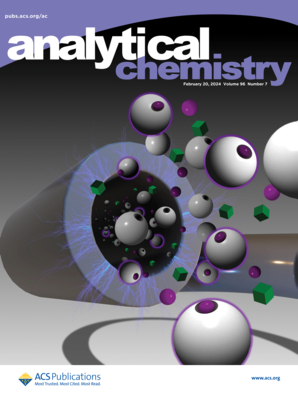Functionalized Polystyrene Sensor for Selective Extraction and Assay of Plutonium at Ultratrace Level in Complex Radionuclide Matrices
IF 6.7
1区 化学
Q1 CHEMISTRY, ANALYTICAL
引用次数: 0
Abstract
The present study focuses on the development of a scintillation sensor specifically designed for the selective extraction and ultratrace detection of Pu in the presence of other α and β-γ emitting radionuclides. To achieve this, a polystyrene (PS) film, embedded with the fluorophore 2,5-diphenyloxazole (PPO) and the activator 1,4-bis(2-methylstyryl)benzene (MSB), has been prepared as the substrate owing to its excellent pulse height response. The Pu selective functional groups have been introduced onto the PS substrate by surface grafting of bis(2-(methacryloyloxy)ethyl) phosphate (BMEP) monomer using in situ ultraviolet (UV) polymerization. The scintillation sensor could be successfully tested for Pu detection in the presence of α (Am, Cm, U) and β-γ (Cs, Ba, and Eu) emitting radionuclides. The sensor has been successfully applied for the uptake and estimation of Pu from a legacy sample containing high activities of 137Cs and 241Am. In order to test the response of the Pu-loaded sensor in the most complex scenario, it has been exposed to a freshly prepared fission product solution. In this case, the uptake of fission product (95Zr and 95Nb) has been observed along with Pu, which introduced significant interference from β particles in the scintillation pulse height spectra of Pu. With optimization of the thickness of the PS substrate, the β contribution could be reduced and Pu could be estimated in such a complex scenario. If the Pu activity is sufficiently high, the PS film can also be subjected to α spectrometry using solid-state Si detectors for quantification of Pu. The developed sensor has been found to be sensitive, selective, and reusable and has a linear response over a wide range of Pu concentrations. Moreover, these sensors are deployable for field applications with the capability of remote monitoring, enabling low-level detection of Pu even in the presence of other interfering radionuclides.

求助全文
约1分钟内获得全文
求助全文
来源期刊

Analytical Chemistry
化学-分析化学
CiteScore
12.10
自引率
12.20%
发文量
1949
审稿时长
1.4 months
期刊介绍:
Analytical Chemistry, a peer-reviewed research journal, focuses on disseminating new and original knowledge across all branches of analytical chemistry. Fundamental articles may explore general principles of chemical measurement science and need not directly address existing or potential analytical methodology. They can be entirely theoretical or report experimental results. Contributions may cover various phases of analytical operations, including sampling, bioanalysis, electrochemistry, mass spectrometry, microscale and nanoscale systems, environmental analysis, separations, spectroscopy, chemical reactions and selectivity, instrumentation, imaging, surface analysis, and data processing. Papers discussing known analytical methods should present a significant, original application of the method, a notable improvement, or results on an important analyte.
 求助内容:
求助内容: 应助结果提醒方式:
应助结果提醒方式:


